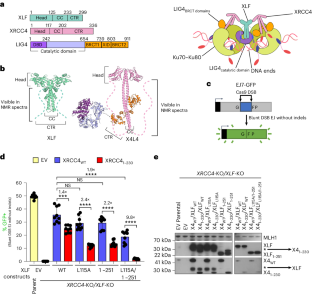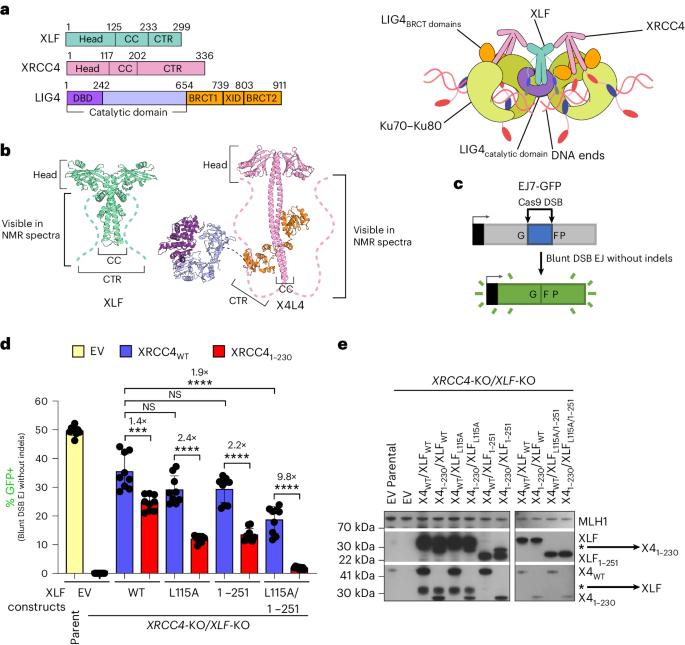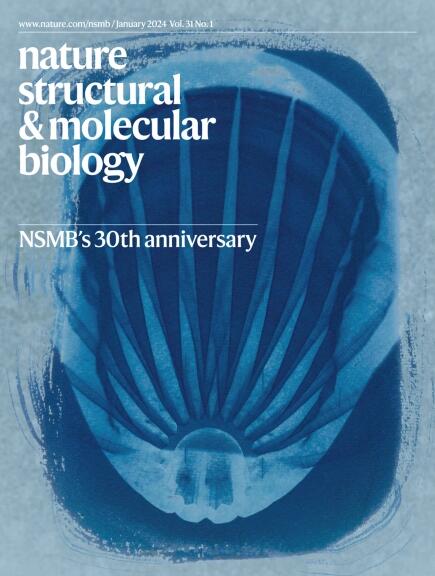Multivalent interactions of the disordered regions of XLF and XRCC4 foster robust cellular NHEJ and drive the formation of ligation-boosting condensates in vitro
IF 12.5
1区 生物学
Q1 BIOCHEMISTRY & MOLECULAR BIOLOGY
引用次数: 0
Abstract
In mammalian cells, DNA double-strand breaks are predominantly repaired by non-homologous end joining (NHEJ). During repair, the Ku70–Ku80 heterodimer (Ku), X-ray repair cross complementing 4 (XRCC4) in complex with DNA ligase 4 (X4L4) and XRCC4-like factor (XLF) form a flexible scaffold that holds the broken DNA ends together. Insights into the architectural organization of the NHEJ scaffold and its regulation by the DNA-dependent protein kinase catalytic subunit (DNA-PKcs) were recently obtained by single-particle cryo-electron microscopy analysis. However, several regions, especially the C-terminal regions (CTRs) of the XRCC4 and XLF scaffolding proteins, have largely remained unresolved in experimental structures, which hampers the understanding of their functions. Here we used magnetic resonance techniques and biochemical assays to comprehensively characterize the interactions and dynamics of the XRCC4 and XLF CTRs at residue resolution. We show that the CTRs of XRCC4 and XLF are intrinsically disordered and form a network of multivalent heterotypic and homotypic interactions that promotes robust cellular NHEJ activity. Importantly, we demonstrate that the multivalent interactions of these CTRs lead to the formation of XLF and X4L4 condensates in vitro, which can recruit relevant effectors and critically stimulate DNA end ligation. Our work highlights the role of disordered regions in the mechanism and dynamics of NHEJ and lays the groundwork for the investigation of NHEJ protein disorder and its associated condensates inside cells with implications in cancer biology, immunology and the development of genome-editing strategies. What is the role of disorder in non-homologous end-joining proteins? The authors use nuclear magnetic resonance to reveal that disordered regions mediate a network of multivalent interactions, promoting biomolecular condensation that accelerates DNA ligation kinetics.


XLF 和 XRCC4 的无序区的多价相互作用促进了细胞 NHEJ 的稳健性,并推动了体外连接促进凝聚物的形成
在哺乳动物细胞中,DNA 双链断裂主要通过非同源末端连接(NHEJ)修复。在修复过程中,Ku70-Ku80异源二聚体(Ku)、X射线修复交叉互补4(XRCC4)与DNA连接酶4(X4L4)和XRCC4样因子(XLF)复合物形成了一个柔性支架,将断裂的DNA末端固定在一起。最近,通过单颗粒冷冻电镜分析,人们深入了解了 NHEJ 支架的结构组织及其受 DNA 依赖性蛋白激酶催化亚基(DNA-PKcs)的调控。然而,XRCC4和XLF支架蛋白的几个区域,尤其是C-末端区域(CTR),在实验结构中基本上仍未解决,这阻碍了对其功能的理解。在这里,我们利用磁共振技术和生化实验,以残基分辨率全面描述了 XRCC4 和 XLF CTR 的相互作用和动力学特征。我们的研究表明,XRCC4 和 XLF 的 CTR 本质上是无序的,并形成了一个多价异型和同型相互作用网络,促进了细胞 NHEJ 活性的稳健性。重要的是,我们证明了这些 CTR 的多价相互作用会导致体外形成 XLF 和 X4L4 凝聚物,从而招募相关效应物并严重刺激 DNA 末端连接。我们的工作强调了无序区在 NHEJ 机制和动力学中的作用,为研究细胞内 NHEJ 蛋白无序及其相关凝聚物奠定了基础,对癌症生物学、免疫学和基因组编辑策略的开发具有重要意义。
本文章由计算机程序翻译,如有差异,请以英文原文为准。
求助全文
约1分钟内获得全文
求助全文
来源期刊

Nature Structural & Molecular Biology
BIOCHEMISTRY & MOLECULAR BIOLOGY-BIOPHYSICS
CiteScore
22.00
自引率
1.80%
发文量
160
审稿时长
3-8 weeks
期刊介绍:
Nature Structural & Molecular Biology is a comprehensive platform that combines structural and molecular research. Our journal focuses on exploring the functional and mechanistic aspects of biological processes, emphasizing how molecular components collaborate to achieve a particular function. While structural data can shed light on these insights, our publication does not require them as a prerequisite.
 求助内容:
求助内容: 应助结果提醒方式:
应助结果提醒方式:


